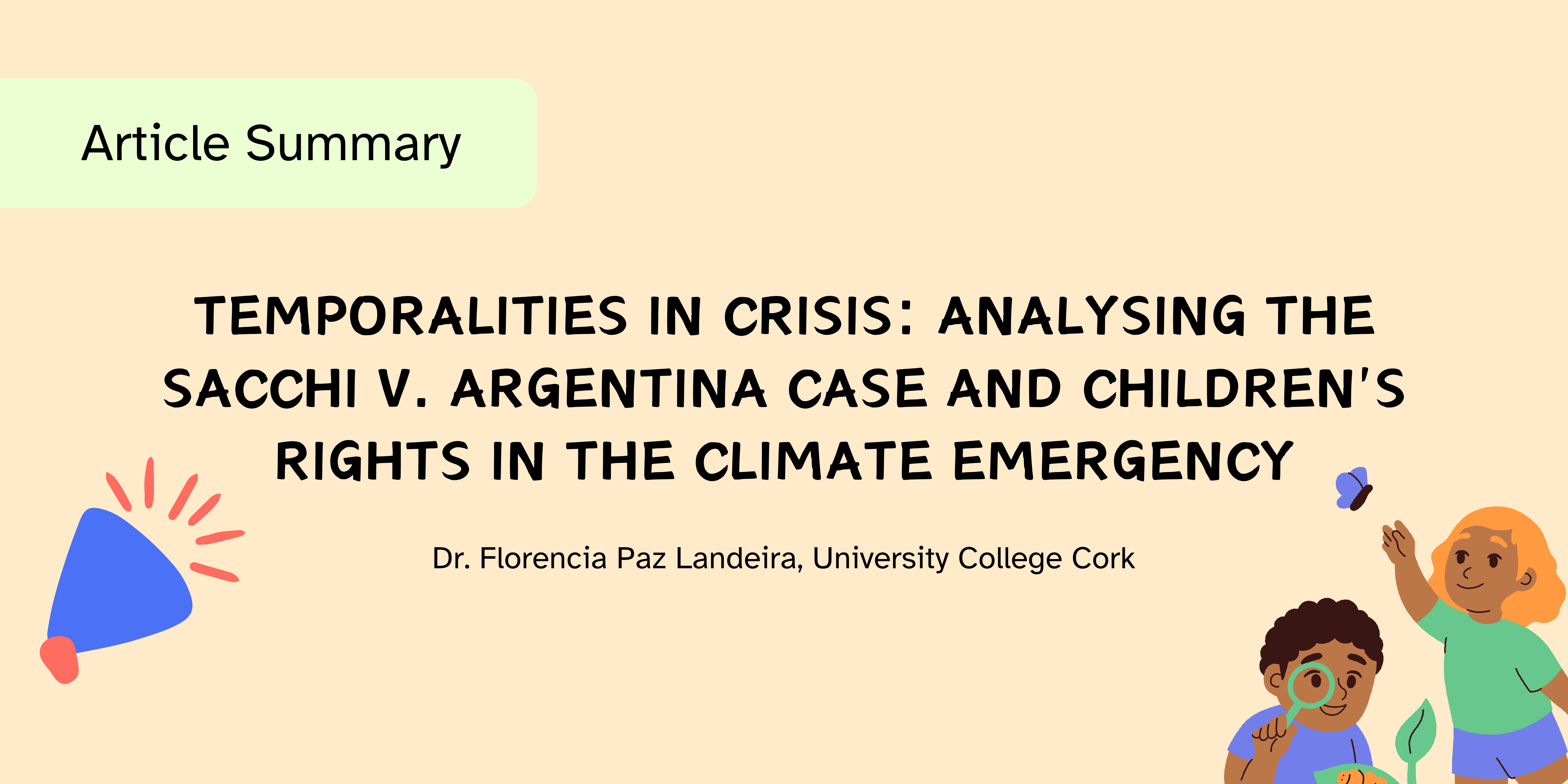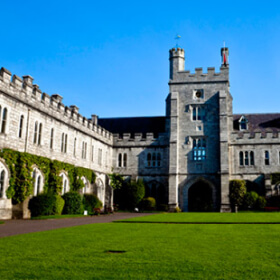Blog
Children, Climate and Time: Key Insights from “Temporalities in Crisis: Analysing the Sacchi v. Argentina Case and Children's Rights in the Climate Emergency”

The accelerating climate emergency is usually measured in tonnes of carbon and degrees of warming. In a recent article, Dr. Florencia Paz Landeira invites readers to look instead at how we experience time in a destabilised world. Children and youth occupy a particularly exposed temporal position: they confront immediate hazards, feel the strain of gradual environmental decline, and foresee a future already circumscribed by present-day emissions. Analysing the landmark case Sacchi v. Argentina through this temporal lens reveals why delay in climate action is itself a violation of children’s rights and why legal institutions must adapt to the pace of planetary change.
What is “temporality” and why does it matter?
Social theorists use temporality to describe the multiple, overlapping ways societies organise and perceive time. The article identifies three layers that structure children’s encounter with the climate crisis:
- Urgency. Rapid-onset hazards—heatwaves, megafires, flash floods—demand immediate protection and adaptation.
- Gradualness or “slow violence.” Sea-level rise, soil salinisation and biodiversity loss unfold imperceptibly until thresholds are crossed, silently undermining livelihoods and health.
- Intergenerational reach. Greenhouse gases emitted today lock in warming for decades, shifting climate burdens toward those who will live longest with the consequences.
Children live within all three clocks at once. Recognising those intertwined temporalities helps explain their insistence on swift, decisive action and frames climate mitigation as a matter of justice, not optional policy.
Method and sources
The study combines three strands of evidence. First, it offers a doctrinal analysis of the CRC’s decision, highlighting what the Committee did—and did not—say about States’ time-sensitive duties. Second, it undertakes a close reading of the written and oral testimonies submitted by the sixteen youth petitioners. Third, it places those materials in conversation with recent scholarship on childhood studies, climate litigation and socio-legal conceptions of time. This mixed approach shows how legal argument, personal narrative and theoretical reflection converge on the same temporal problem.
Children’s narratives: time made visible
Personal testimony transforms abstract climate statistics into lived temporal experience.
- Heightened immediacy. David Ackley III, from the Marshall Islands, fears the next king tide that could breach protective seawalls. Storm surges, once a seasonal marker, now signal existential risk.
- Psychological drag. Carl Smith, a Yupiaq teenager from Alaska, describes cultural loss “inch by inch” as thinning river ice shortens the hunting season and undermines intergenerational knowledge.
- Moral foresight. Greta Thunberg reminds policymakers that actions “right now will affect my entire life and the lives of my children or grandchildren,” collapsing the distance between present decision and future harm.
Together, these accounts expose how the climate crisis compresses temporal horizons: the future arrives prematurely, while legal and political systems remain slow to respond.
A temporal reading of the legal arguments
The petitioners framed delay itself as a rights violation. They alleged that the respondent States breached four provisions of the Convention on the Rights of the Child by allowing avoidable emissions to continue:
| CRC right |
Climate-related infringement |
| Article 6 – Life |
Intensified storms, heat and disease threaten survival. |
| Article 24 – Health |
Smoke, malnutrition and vector shifts impair physical and mental well-being. |
| Article 30 – Culture |
Environmental degradation erodes Indigenous and local traditions. |
| Article 3 – Best interests of the child |
Policy delay transfers disproportionate burdens to younger generations. |
Central to their claim is the precautionary principle: where credible scientific evidence points to serious or irreversible harm, States must act without waiting for complete certainty. Requiring these children to exhaust years of domestic litigation—while greenhouse-gas concentrations rise—would nullify the very rights the Convention is intended to protect. The article therefore characterises “slow justice” as an injustice in its own right.
Although the Committee ultimately declined jurisdiction for procedural reasons, it accepted that cross-border emissions can engage State responsibility—an important doctrinal step that reinforces the temporal claim that harm is accumulating continuously, not in discrete national compartments.
Contribution to childhood studies
Conventional developmental models treat children as “adults-in-waiting,” valued mainly for their future potential. The article’s analysis aligns with recent scholarship that contests this teleology. Children are present-day social actors whose life courses are already entwined with climate risk. By foregrounding temporality, the article shows how their agency arises precisely from their acute awareness of accelerating and overlapping time scales.
Policy and advocacy implications
The temporal perspective advanced in the article leads to four practical recommendations:
- Treat delay as continuing harm. Legislative and judicial bodies should recognise that every year of inadequate mitigation aggravates violations of children’s rights.
- Realign legal procedures with climatic time. Where domestic remedies are demonstrably ineffective or excessively slow, international and regional mechanisms should be empowered to act swiftly.
- Institutionalise intergenerational equity. Climate impact assessments, budgets and infrastructure plans must evaluate consequences for those under eighteen and for future cohorts.
- Guarantee meaningful participation. Children and adolescents should have structured opportunities to influence climate policy, monitor implementation and seek redress.
These measures are not accessary; they follow directly from the insight that law, too, is a producer of time—one that must now match the tempo of a warming planet.
Conclusion: justice at the speed of the crisis
The article “Temporalities in Crisis: Analysing the Sacchi v. Argentina Case and Children's Rights in the Climate Emergency” argues that the climate emergency is simultaneously a crisis of physics and a crisis of legal time. Sacchi v. Argentina demonstrates the tension between an atmosphere that responds in decades and institutions that deliberate in decades. Protecting children’s rights therefore requires recalibrating legal and political tempos so that they do not lag fatally behind environmental realities. When time accelerates, justice must accelerate with it—or risk becoming another form of climate loss.
This article was first published in Children & Society on March 16, 2025. Access here to read the full article: https://onlinelibrary.wiley.com/doi/10.1111/chso.12955
You can access a summary of this article here.

